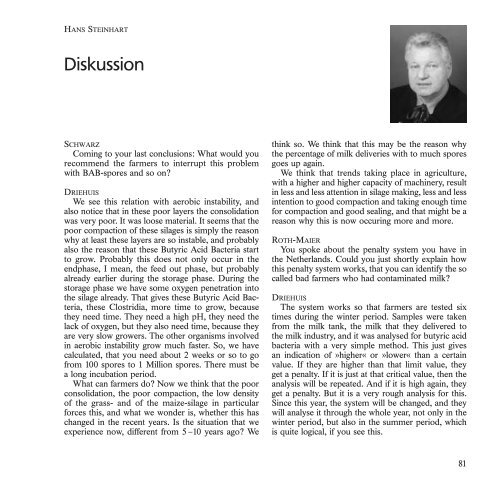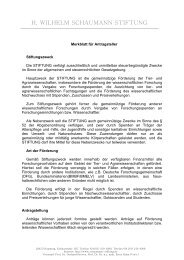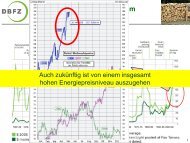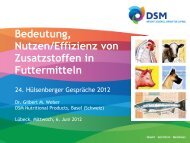Broschüre 2004 zum Download (pdf | 1994,28 KB) - H. Wilhelm ...
Broschüre 2004 zum Download (pdf | 1994,28 KB) - H. Wilhelm ...
Broschüre 2004 zum Download (pdf | 1994,28 KB) - H. Wilhelm ...
Sie wollen auch ein ePaper? Erhöhen Sie die Reichweite Ihrer Titel.
YUMPU macht aus Druck-PDFs automatisch weboptimierte ePaper, die Google liebt.
HANS STEINHART<br />
Diskussion<br />
SCHWARZ<br />
Coming to your last conclusions: What would you<br />
recommend the farmers to interrupt this problem<br />
with BAB-spores and so on?<br />
DRIEHUIS<br />
We see this relation with aerobic instability, and<br />
also notice that in these poor layers the consolidation<br />
was very poor. It was loose material. It seems that the<br />
poor compaction of these silages is simply the reason<br />
why at least these layers are so instable, and probably<br />
also the reason that these Butyric Acid Bacteria start<br />
to grow. Probably this does not only occur in the<br />
endphase, I mean, the feed out phase, but probably<br />
already earlier during the storage phase. During the<br />
storage phase we have some oxygen penetration into<br />
the silage already. That gives these Butyric Acid Bacteria,<br />
these Clostridia, more time to grow, because<br />
they need time. They need a high pH, they need the<br />
lack of oxygen, but they also need time, because they<br />
are very slow growers. The other organisms involved<br />
in aerobic instability grow much faster. So, we have<br />
calculated, that you need about 2 weeks or so to go<br />
from 100 spores to 1 Million spores. There must be<br />
a long incubation period.<br />
What can farmers do? Now we think that the poor<br />
consolidation, the poor compaction, the low density<br />
of the grass- and of the maize-silage in particular<br />
forces this, and what we wonder is, whether this has<br />
changed in the recent years. Is the situation that we<br />
experience now, different from 5 –10 years ago? We<br />
think so. We think that this may be the reason why<br />
the percentage of milk deliveries with to much spores<br />
goes up again.<br />
We think that trends taking place in agriculture,<br />
with a higher and higher capacity of machinery, result<br />
in less and less attention in silage making, less and less<br />
intention to good compaction and taking enough time<br />
for compaction and good sealing, and that might be a<br />
reason why this is now occuring more and more.<br />
ROTH-MAIER<br />
You spoke about the penalty system you have in<br />
the Netherlands. Could you just shortly explain how<br />
this penalty system works, that you can identify the so<br />
called bad farmers who had contaminated milk?<br />
DRIEHUIS<br />
The system works so that farmers are tested six<br />
times during the winter period. Samples were taken<br />
from the milk tank, the milk that they delivered to<br />
the milk industry, and it was analysed for butyric acid<br />
bacteria with a very simple method. This just gives<br />
an indication of »higher« or »lower« than a certain<br />
value. If they are higher than that limit value, they<br />
get a penalty. If it is just at that critical value, then the<br />
analysis will be repeated. And if it is high again, they<br />
get a penalty. But it is a very rough analysis for this.<br />
Since this year, the system will be changed, and they<br />
will analyse it through the whole year, not only in the<br />
winter period, but also in the summer period, which<br />
is quite logical, if you see this.<br />
81











